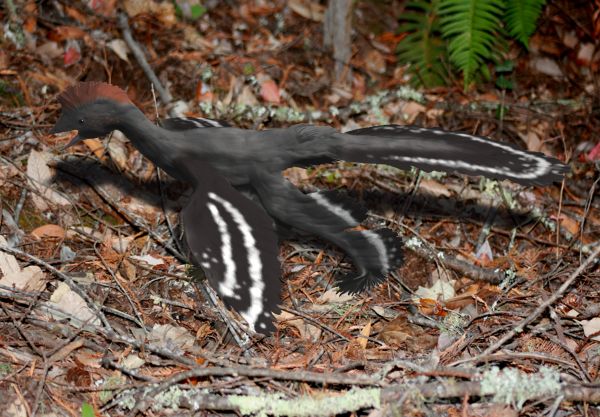
Scansoriopteryx heilmanni, a tiny proto-bird from the late Jurassic of China.
Artwork by Matthew Martyniuk, via Wikipedia, GNU Free Documentation/Creative Commons Attribution
| Coelurosauria | ||
| The Vertebrates | Avialae |
| Vertebrates Home | Vertebrate | Vertebrate |
|
Abbreviated Dendrogram
Dinosauria
├─Ornithischia
└─┬─Sauropodomorpha
└─Theropoda
│
└─Coelurosauria
├─Tyrannosauroidea
└─┬─Ornithomimosauria
└─┬─Maniraptora
├─Therizinosauroidea
└─Metornithes
├─Alvarezsauridae
└─┬─Oviraptorosauria
└─Paraves
├─Deinonychosauria
│ ├─Troodontidae
│ └─Dromaeosauridae
└─Avialae
├─Scansoriopterygidae
└─Aves
|
Contents
Index |
 Scansoriopteryx heilmanni, a tiny proto-bird from the late Jurassic of China. Artwork by Matthew Martyniuk, via Wikipedia, GNU Free Documentation/Creative Commons Attribution |
Illustrating the complex character of evolution at the dino to bird boundary, here are a group of arboreal proto-birds, or possibly very early true birds, known mostly from the fossil remains of tiny, sparrow-sized juveniles.. They have been variously considered as more primitive than (Zhang et al 2008, Lee & Worthy 2011), or more advanced than (Xu et al 2011), Archaeopteryx. Although universally classified as Avialae close to Archaeopteryx, and hence to tryue birds, their precise evolutionary relationships are uncertain MAK120307
Avialae. Daffy Duck > Deinonychus antirrhopus.
Range: From Late Jurassic
Phylogeny: Paraves : Deinonychosauria + * : Aves + Scansoriopterygidae
Comments: The clade that includes all birds and their immediate proto-bird ancestors and relatives. The almost unanimous position among paleontologists is that Archaeopteryx is more derived than Deinonychus. Two rare dissenting hypotheses are paleornithologist Alan Feduccia (who reject a dinosaur origin for birds) Triassic archosaur origin, and Greg Paul's popular (among lay-enthusiasts) neoflightless theropod hypothesis (Deinonychus as a descendant of Archaeopteryx rather than a cousin). More recently, Feduccia has modified his stance and now argues (like Greg Paul) that the very birdlike Dromaeosaurids and Oviraptorosauria, are actually neo-flightless avian lineages, probably more derived than Archaeopteryx, that through homoplasy associated with loss of flight and secondary acquisition of cursoriality, converged with theropod dinosaurs (Wikipedia). So far, cladistic evidence does not support the neo-flightless hypothesis MAK120307
Scansoriopterygidae. Epidexipteryx, Scansoriopteryx
Range: Late Jurassic of China
Comments: from Wikipedia: Scansoriopterygids can be characterized by their extremely elongated third fingers, which are longer than the first and second digits of the hand (in all other known theropods, the second finger is the longest). Other features shared within the group include short and high skulls with down turned lower jaws and large front teeth, and long arms. Tail length, however, varied significantly among scansoriopterygids. Epidexipteryx had a short tail (70% the length of the torso), anchoring long tail feathers, while Scansoriopteryx had a very long tail (over three times as long as the torso) with a short spray of feathers at the tip. All three described scansoripterygid specimens preserve the fossilized traces of feathers covering their bodies (Czerkas & Yuan 2002, Zhang et al 2008)
page MAK120307